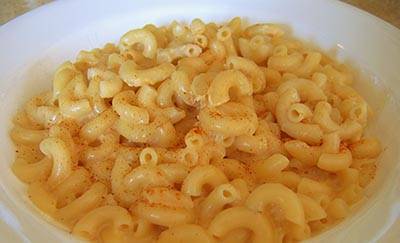Stovetop Mac and Cheese
 Macaroni came to the United States in the later half of the 18th century. Originally the food of the elite, the pasta was cooked for half an hour, drained, smothered with cheese and cream, and baked. Despite the fact that it was overcooked by more than three fold, the dish grew in popularity and made its way to working class tables by the mid 1800s. Of course, this caused it to be removed from the menus of high-end restaurants of the time. Apparently the rich really are different.
Macaroni came to the United States in the later half of the 18th century. Originally the food of the elite, the pasta was cooked for half an hour, drained, smothered with cheese and cream, and baked. Despite the fact that it was overcooked by more than three fold, the dish grew in popularity and made its way to working class tables by the mid 1800s. Of course, this caused it to be removed from the menus of high-end restaurants of the time. Apparently the rich really are different.
During the Great Depression, macaroni sales continued to increase, which prompted Kraft to begin marketing a macaroni and cheese mix in 1937. The mix took off with war time rationing and cemented the dish’s status as a way to make due.
Regardless of whether it’s the version with the day glow orange powder or the version with “pasteurized prepared cheese product,” what comes out of the blue box doesn’t resemble what grandma used to bring to the family reunion, let alone something Thomas Jefferson and his pals would have eaten.
With the comfort stripped from this comfort food, maverick restaurateurs began resurrecting it on menus along with potpies and various meatloaves in the late 1980s. Over the years, they’ve topped it with panko, gilded it with truffles, spiked it with bacon, and baked it in muffin tins for a cocktail snack, all in an effort to swing the pendulum the other way.
Homemade, or housemade as the case may be, baked macaroni and cheese can be truly comforting. But just because you don’t have hours to make dinner, doesn’t mean you can’t make a comforting version of macaroni and cheese, one with actual cheese, on the stovetop. It’s infinitely more satisfying than the box version and you can do it in the same amount of time.
The aged Gouda in the recipe below is not the same as younger, often smoked, Gouda. Aged Gouda is golden like butterscotch and nutty with a granular texture like Parmesan. Like Parmesan, it melts instantly. Unfortunately, three to five year-old Goudas aren’t widely available domestically, so you are most likely looking at something from Holland with about the same price tag as Parmesan-Reggiano—$16 to $17 a pound. But, you need only four ounces. You can find aged Gouda at Schnuck’s and World Harvest in Champaign and at Common Ground in Urbana. If you can’t bring yourself to spend $4 on cheese for a dish that sometimes retails for as little as 49 cents a box, you can substitute an aged cheddar. Try to get something at least 4 years old. Dubliner cheese from Ireland also is an option.
Evaporated milk shares shelf space with sweetened condensed milk in the baking aisle. The evaporation process removes over half the water from the milk, leaving a richer, slightly nutty result. Unlike cream, it won’t overwhelm the cheese in the dish. The egg is a classic way to pull the sauce together in lieu of cream and larger amounts of cheese. The amount of salt you need to season the dish will vary by the cheese you use and whether you are using unsalted butter.
Stovetop Mac and Cheese
Serves 3
6 oz elbow macaroni
4 oz of finely grated aged Gouda
2 T finely minced onion
2 T butter
8 oz evaporated milk
Dash of cayenne
1 egg
Salt to taste
Boil the macaroni until it is al dente. Meanwhile, mince the onion, grate the cheese, and pour 8 oz of the evaporated milk into a small bowl.
Drain the pasta. In a heavy saucepan, melt the butter and sauté the onion. As the onion becomes translucent, reduce the heat to medium. Add half the milk and add the cayenne. Allow the milk to simmer while beating the egg into the remaining half of the milk and set aside. Add the pasta to the saucepan and stir. Stir in cheese. Stir in the milk-egg mixture until the resulting sauce just thickens, being careful not to curdle the egg. Remove the pan from the heat if you’re worried about curdling. Once the mixture thickens, taste for salt, season and serve.








